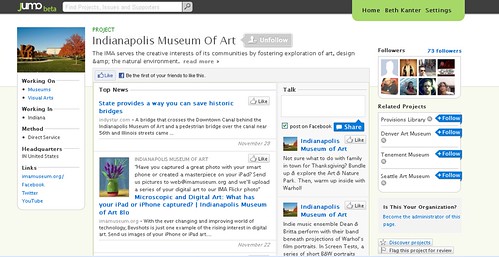Note from Beth: The long anticipated social network site for social change, Jumo, launched. Here’s the article from today’s New York Times. Many of us have been up early playing with Jumo, setting up our individual profiles and finding issues and organizations or setting up profiles for organizations. It is still clearly in beta, with the usual tech glitches and 500 errors, which will smooth out as more people play with it and give them feedback. As the platform matures, we’ll get a better sense of the power and potential of this network that lets people find, connect, and support social change organizations and issues. Amy Sample Ward shares her first reflections and critique of the platform and wonders what’s the point?
The platform was seeded with some initial organization profiles and a focused set of issues. The organizations are a combination of smaller, progressive organizations like Ushahidi and the Sunlight Foundation and large venerable institutions like NPR and the Kennedy Center for the Performing Arts. Anyone can set up a profile for an organization (it prompts for an EIN number (but not required) and Facebook account url) and you can opt to be the administrator. Charities outside the US can set up a profile. To generate a robust profile, your organization should be able to plug in existing social media presences (Flickr, Twitter, YouTube, Blog RSS Feed, Etc) so it seems to favor organizations that have already established a social media content strategy.
Jumo helps connects people with issues and organizations on the first rung of the ladder of engagement, but the challenge will be how to cultivate relationships to bring people up that ladder to higher levels of engagement and involvement – from following and connecting to making donations to making change offline. My colleague, Evone Heyning, calls this “more sticky interactions.” It will also be interesting to track how Jumo helps organizations and causes attract new supporters and what is required in terms of time commitment and strategy to be successful.
My colleague, Steve MacLaughlin, who is on the East Coast and had a jump start this morning offers his first take on Jumo. If you have had a change to play with Jumo and have some insights, please share in the comments.
What is Jumo? by Steve MacLaughlin
Jumo means “together in concert” in Yoruba, a West African language. But it’s also the latest online creation of Chris Hughes, a co-founder of Facebook and director of online organizing for Barack Obama’s 2008 campaign. Details about the project have been hard to come by over the past few months, but here’s what we know:
What
Since the beginning, Hughes has said that Jumo is “an online platform to connect individuals and organizations working to change the world.” GuideStar does have Jumo International listed as a nonprofit organization but very little information is shown and likely won’t be until they file their first 990 with the IRS.
“We’ll be matching people based on their skills and interests with organizations around the world that need their input. It’s a discovery process that first matches, then helps people build relationships, then let’s people share their resources.”- Chris Hughes
Jumo has been raising $2 million in funding from individuals and foundations. About $500,000 came from unnamed individuals in the early days and in September 2010, Omidyar Network announced a grant of up to $750,000. By November 2010, Jumo noted in a New York Times article that they’ve raised $3.5 million.
Who
Chris Hughes brought in Kirsten Titus as Managing director of Jumo. She brings experience from working in and around the nonprofit sector. Hughes also enlisted Scott Thomas, former director of design with the Obama campaign and author of Designing Obama. He has also put together a team of advisers including Jeffrey David Sachs, Director of the Earth Institute at Columbia University, Jacqueline Novogratz, CEO of the Acumen Fund, and Linda Rottenberg is CEO and Co-founder of Endeavor.
“We saw on the Obama campaign you’ve got to combine content and technology to facilitate action. The most important factor in spurring someone to action is timely, personally and relevant content delivered carefully and consistently over an extended period of time.” – Chris Hughes
Jumo has since hired several developers and is paying out a $5,000 referral fee to people. There are still some job openings, including a Monetization Director to help Jumo “achieve financial self-sustainability through the development of revenue-generating products.”
Where
Jumo setup their offices in New York City’s SoHo neighborhood. They have also been very active on Facebook and Twitter along with a few entries on the Jumo blog. Not to mention a lot of press coverage in The Huffington Post, The Wall Street Journal, Fast Company, Mashable, The Chronicle of Philanthropy, and The New York Times.
When
The Jumo website had its soft launch back on March 18, 2010. In the very early days of the website they had visitors answer a series of questions about interests, skills, and cause activities. Two of the questions were “Which of these places would you most like to visit? Argentina, France, India, or Kenya?” and “On Sunday, are you most likely to be: at brunch, at church, at a museum, or watching the big game?” It’s unclear what was done with the information captured and that area of the website has been inaccessible for some time now.
“The last thing I want to do is add yet another site to a nonprofit’s plate. I don’t want them to have to go to yet another destination to share who they are and the work that they’re doing.” – Chris Hughes
The beta launch of Jumo on November 30, 2010 will help users find causes to match their interests, likes and preferences. Users will be able to follow nonprofits to receive updates in their news feed and will be able to support those organizations in a variety of ways.
Jumo users must have a Facebook account and are walked through three simple steps to register for the website: Create Your Account, Your Interests, and Create Your Profile. After giving Jumo some basic details and your interests the site lets you start picking projects that you are interested in. Jumo was seeded with more than 3,000 issues and groups, but anyone with a social mission can create a page. The site then uses your location to show organizations in your area.
After completing these first few steps the screen then shows your very own social media dashboard with information about the organizations you are following. This is also where the connection to your Facebook account comes into play. Your friends on Facebook that have Jumo accounts also start to appear in the “Talk” sidebar of the website.
What also becomes clear very quickly is that organizations that have embraced the use of social media get a lot more leverage on Jumo. National Wildlife Federation, for example, is very active on various social networking websites and they immediately appeared in several places on my Jumo page.
So What and Who Cares
Jumo is not the first initiative to use social media in the nonprofit sector and it won’t be the last. Will millions of people sign-up, actively participate, and help drive change? My guess would be as accurate as anyone else at this point. But this is an important step for the nonprofit sector and its move into the digital age.
The New York Times had an article on the day of Jumo’s launch titled: “A Facebook Founder Begins a Social Network Focused on Charities.” My quote in the article sums things up — “It’s still not clear whether or not followers translate to volunteers and donors. But people that are more engaged with nonprofits are most likely to become a donor or support them in another way.”
We are entering a new period where people from outside the nonprofit sector are going to try their hand at driving change. They bring with them new ideas, approaches, and tools to engaging with people. Their experience comes from a digital perspective and there is no such thing as “we’ve always done it this way.” Organizations trying to change the world can certainly benefit from changes in how they engage with supporters.
What you think of Jumo’s potential?
Steve MacLaughlin is the Director of Internet Solutions at Blackbaud and is a frequent blogger, presenter, and writer about technology trends in the nonprofit industry. This post is also published on Steve’s blog.
Updates: I’m adding some additional posts by nonprofit folks about Jumo
My Thoughts on Jumo by Steve Hopkins
Is Jumo Worth The Hype? by Tom Watkins

